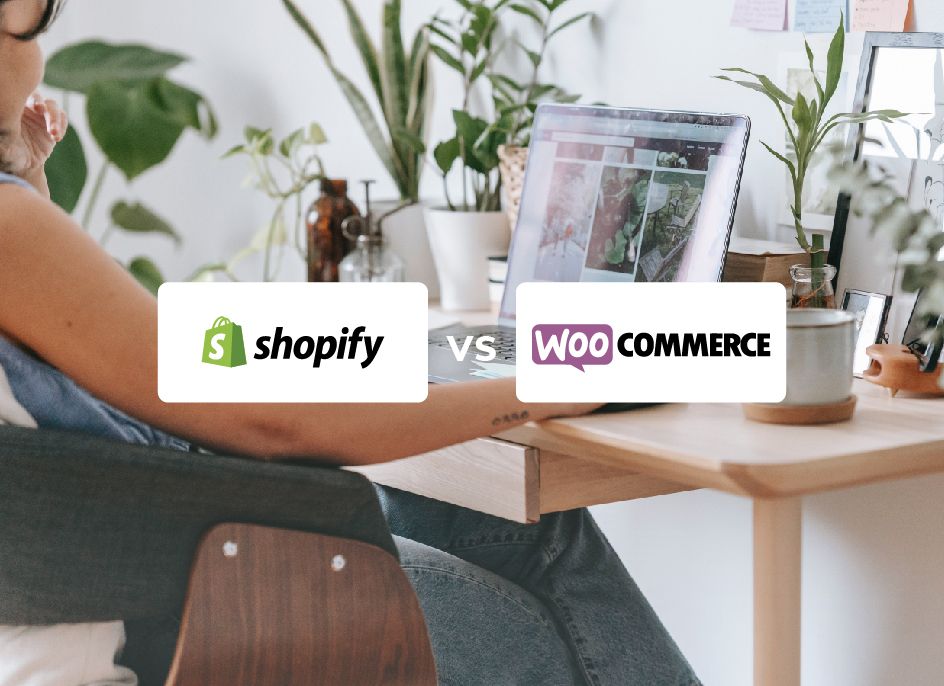Shopify vs WooCommerce — Choose a Platform for Your POD Business
Article • June 22, 2021 • 7 min read
Which one to choose for your print-on-demand business: Shopify or WooCommerce? We've got the answer to this difficult question!

Which one to choose for your print-on-demand business: Shopify or WooCommerce? We've got the answer to this difficult question! Keep reading to find a comprehensive comparison of the two platforms based on e-commerce package, beginner-friendliness, customer support, payment options, price, SEO functionality, and customization to finally decide which fits you best!
Inside you'll find:
1. Shopify vs WooCommerce:
• Price
5. Sum Up
E-Commerce Package
Shopify is a hosted e-commerce platform, which means that you don’t have to worry about hosting and security when building an online store. It provides you with unlimited storage, maintenance, and backup, as well as free subdomains and secure sockets layers (SSL) certificates. In addition, you don’t need to install, manage, or update any software.
However, Shopify also has complete control over your store and can limit, block or terminate your access, which means you're at risk of losing your business at any moment.
WooCommerce is an open-source platform, meaning you need to manage every aspect of the store's functionality, from hosting and maintenance to security and backups. Additionally, you need to update your software quite often. On the other hand, you are in total control of your shop and can obtain its copy. Therefore, your business is safe since WooCommerce cannot close or block it.
Beginner-Friendliness
With Shopify, it takes little to no time to create an online shop and start selling. The platform is straightforward and simple, allowing users to create a store in just a few clicks. Even people with no experience in coding can have a store up and running in a matter of hours.
WooCommerce isn’t exactly beginner-friendly and has a rather steep learning curve. The platform requires users to have at least some knowledge in coding to build a store. Additionally, it takes a considerable amount of time to set up the store and customize it.
Customer Support
Shopify offers 24/7 customer support, reachable via phone, email, and live chat. Whenever you have a question or face a problem, Shopify is always there to help. That's why the process of setting up a store becomes seamless and smooth.
WooCommerce doesn’t provide instant customer support, meaning that if you encounter any issues, you won’t be able to reach them at. You can either submit a ticket and wait for the reply or rely on forums, guides, and step-by-step instructions. In any case, urgent problems won't be solved as easily as with Shopify.
Payment Options
Shopify offers various payment choices:
1. Company's custom solution — Shopify Payments (available in a limited number of countries);
2. More than 100 third-party payment gateways (in this case, Shopify charges you between 2% and 3% per transaction).
WooCommerce also has its own WooCommerce Payments and a wide range of third-party payment gateways. While Shopify offers a wider range of payment options, WooCommerce doesn’t charge a fee for using third-party payment options.
Price
Shopify charges you a monthly fee, and the subscription plans range from $30 to $300 a month. Additionally, the prices are likely to grow with time if you extend the store’s functionality or upgrade your plan.
WooCommerce is free and doesn’t charge you a monthly fee, however, there are some related expenses. For instance, you will need to purchase a hosting plan, domain name, SSL certificate, which altogether may reach the cost you'd pay for Shopify’s monthly subscription.
Search Engine Optimization
Shopify has certain limitations when it comes to SEO. For example, users can’t fully customize their URLs due to rigid URL structure. At the same time, Shopify does have some SEO plugins and allows adding basic SEO information to your store.
As WooCommerce is a plugin for WordPress, it is equipped with a wide range of tools for search engine optimization. In particular, you can use Yoast, a WordPress plugin, to optimize your site and manage every SEO-related detail. Besides that, WooCommerce offers plenty of other SEO plugins to boost your store.
Customization
Shopify offers 70+ free and premium website templates. The themes are well-structured and polished, allowing you to choose the design that fits you best. However, you can’t customize them unless you know how
to code. As a result, you can be left with a limited number of themes without the right one for your store.
Meanwhile, WooCommerce provides its users with limitless customization. There is a wide variety of free and paid themes and plugins available, allowing you to personalize your online store. You can create your own themes as well to make your online shop unique and special.
Shopify vs WooCommerce: which one to choose?
| Characteristics | Shopify | WooCommerce |
| E-Commerce Package | Hosted platform (everything is included) | Open-source platform (need to manage hosting, maintenance, security, backups, etc) |
| Beginner-Friendliness | For newbies | For users skilled in coding |
| Customer Support | 24/7, available via chat, email, and phone | No developed customer support system |
| Payment Options | Custom solution; lots of third party gateways | Custom solution; a limited number of third party gateways |
| Price | Paid platform, several subscription plans | Free platform, but you pay for hosting, security, etc. |
| Search Engine Optimization | Limited options for SEO | Wide range of SEO methods, including WordPress tools |
| Customization | A limited number of themes and designs | Wide variety of options |
Why Choose Shopify?
• You are a newbie with limited experience in coding
• 24/7 support is necessary for you
• You are ready to invest some money into your business
• You just want to sell your products; customization isn’t a priority
• You need your store up and running in a short period of time.
Why Choose WooCommerce?
• You have skills and knowledge in coding
• You want to have greater control over your shop’s design and hosting
• You are ready to invest time and effort into setting up your site
• You aim to make a personalized store that requires a lot of customization.
Still unsure about either of those platforms?
Check out other e-commerce solutions to build your print-on-demand store.
Alternative E-Commerce Solutions
Wix is a cloud-based website builder that allows you to either build a store from scratch or to choose from hundreds of templates. It is beginner-friendly, with middle customization options, and is better for those who plan to sell a few items online rather than create a fully functional online store.
Ecwid is an e-commerce solution that you can use with almost any content management system (CMS) platform. The platform is beginner-friendly and allows for multichannel selling. However, it has limited design options, its free plan is very narrow in functionality, and it has small-scale sales tools, meaning that it won’t be suitable for large or fast-growing businesses.
Magento is an open-source e-commerce platform with a broad community of users, flexible functionality, and an extensive range of options. It is an excellent choice for medium and large businesses that have lots of customers and sell a wide variety of products. At the same time, it is not easy to install and requires substantial coding knowledge, which makes it a poor choice for novices.
If you are just not ready to dedicate time and effort to build your online store from scratch, there is still a solution!
The following platforms allow you to create an account and start selling your products today:
With eBay, you can start selling your print products in just 3 simple steps:
- Create an account
- Get immediate access to a far-reaching community of users
- Earn profit.
You can set fixed prices on your products, put them on auction, or bargain with customers. However, you should take into account the high fees and the absence of a fulfillment service when choosing this platform.
On Amazon, you can not only sell your products — but the platform also takes care of storage, packing, and shipping for you. It also has exceptionally high traffic since millions of people visit the site every month. At the same time, high competition is typical for this platform, thus, it’s quite hard to create a strong brand image while selling on Amazon.
If you already have several online stores on different platforms, check out Order Desk. It will help you organize your orders and keep track of all the activities in one place.
Wrapping Up
No matter what kind of print-on-demand business you have, or are about to start, there are plenty of ready-to-go solutions.
If you are a newbie and are just getting started, consider choosing Shopify, Wix, or Ecwid to build your online presence.
If you have sufficient coding skills and don’t mind spending some time on building your online shop, WooCommerce is the platform for you.
If you have lots of experience in coding or you can hire a professional web developer, and want to bring your medium or large business to a new level, choose Magento.
If building a website isn’t for you, and you simply want to sell online, eBay and Amazon provide you with such an opportunity.
Finally, if you sell on multiple platforms and want to make your business more organized and efficient, you can keep track of all your orders in one place with the Order Desk app.


